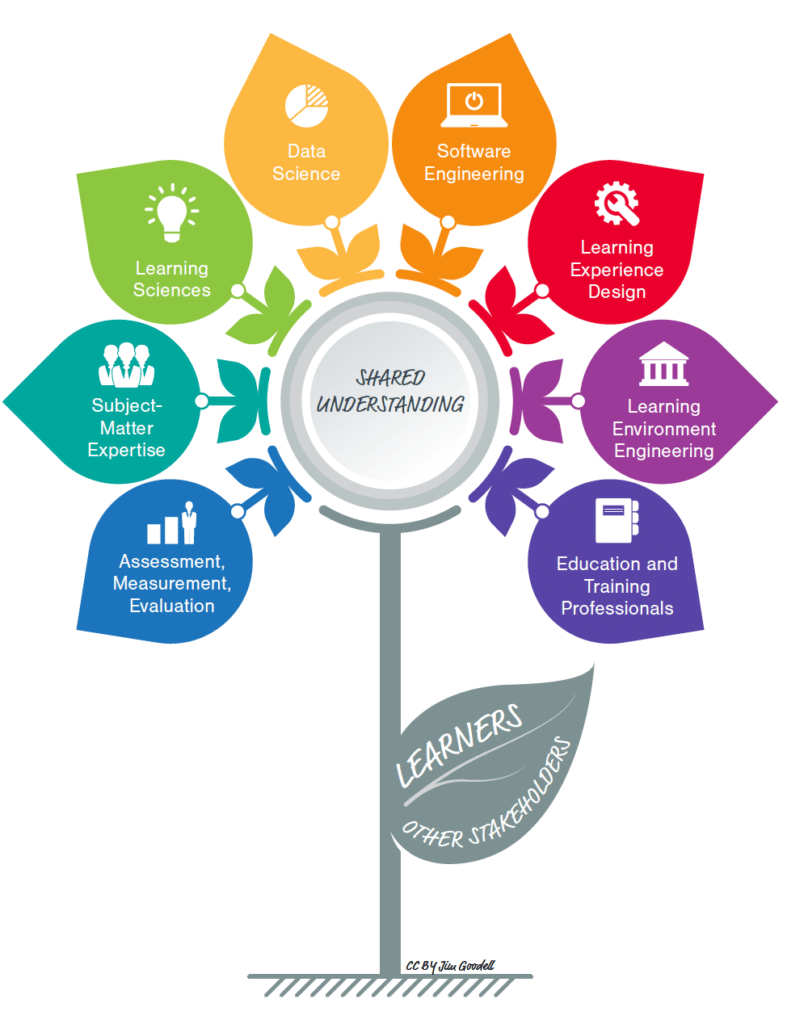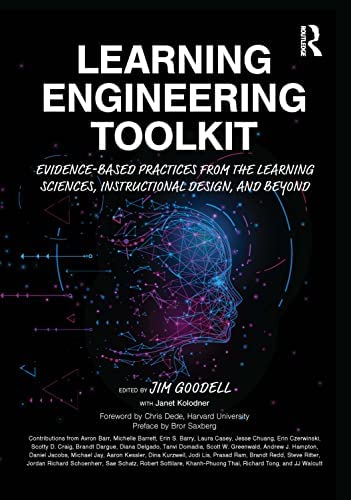Jim Goodell, co-editor of Learning Engineering Toolkit: Evidence-Based Practices from the Learning Sciences, Instructional Design, and Beyond, is a passionate proponent of learning engineering. He’s the director of innovation at Quality Information Partners and chairs the Learning Technology Standards Committee at the IEEE Standards Association and IEEE ICICLE.
In this episode of the Leading Learning Podcast, co-host Celisa Steele talks with Jim about learning engineering: what it is, its relationship with learning science, its ethical considerations, and how it can be used to design and improve learning experiences. They also discuss the Learning Engineering Toolkit and what learning businesses can do to adopt a learning engineering approach.
To tune in, listen below. To make sure you catch all future episodes, be sure to subscribe via RSS, Apple Podcasts, Spotify, Stitcher Radio, iHeartRadio, PodBean, or any podcatcher service you may use (e.g., Overcast). And, if you like the podcast, be sure to give it a tweet.
Listen to the Show
Access the Transcript
Download a PDF transcript of this episode’s audio.
Read the Show Notes
[00:00] – Intro
Defining Learning Engineering
[01:47] – How do you define “learning engineering,” and how do you distinguish it from “learning design”?
Learning engineering is a process and practice that applies the learning sciences using human-centered engineering design methodologies and data-informed decision-making to support learners in their development.
This definition was developed by the IEEE Standards Association and ICICLE. (IEEE is the standards organization that developed the standards behind Wi-Fi and Bluetooth.)
Learning design overlaps with learning engineering. If what you do involves applying the learning sciences, using human-centered design, and/or data-informed decision-making, then you might already be doing learning engineering.
Learning engineering is an iterative process.
Because learning engineering draws on competencies from many domains, it’s most often a team sport–no single indvidual is likely to have the full range of needed knowledge and skills.

Learning Engineering Toolkit
[04:09] – What prompted you to put out the Learning Engineering Toolkit book, and why do you feel like this is the right moment for it?
The book started as a personal journey for Jim. He made it a quest to learn as much as he could about how people learn.
And what I discovered in that process was there are so many learning sciences discoveries that just aren’t being applied at scale. And that’s really what learning engineering tries to do, is to move from the science of learning to scaled implementation of those findings.
Jim Goodell
To learn more about learning science, check out our related series “Learning Science for Learning Businesses.”
Jim encountered ICICLE, the IEEE Industry Connections Industry Consortium on Learning Engineering. Those involved in ICICLE were debating the definition of “learning engineering.” The term is over 50 years old and was coined by Herb Simon, a Nobel laureate from Carnegie Mellon University.
Jim wanted to learn more about the term and the field, so he began interviewing different people to get their take on what learning engineering is. That was the beginning of the book.
Obstacles in Learning Science
[07:06] – What’s preventing large-scale application of discoveries from learning science? How can learning engineering help us overcome obstacles that the application of learning science has faced?
Learning is a complex endeavor, but engineering has addressed other complex domains. Part of what’s holding us back in the learning field is that we tend to use processes that are more of an art than science and engineering.
We use a learning design process like ADDIE, which can be used as an iterative process, but often the constraints force us to take a one-and-done approach to design and development.
Learning engineering is in its infancy. But, like other areas of engineering, it has benefits that will grow over time.
So there’s a real opportunity for learning engineering over time to develop into a set of reusable practices and components that can allow us to do much more with the resources we have and create better learning for everyone.
Jim Goodell
Partner with Tagoras
[10:49] – At Tagoras, we’re experts in the global business of lifelong learning, and we use our expertise to help clients better understand their markets, connect with new customers, make the right investment decisions, and grow their learning businesses.
We achieve these goals through expert market assessment, strategy formulation, and platform selection services. If you are looking for a partner to help your learning business achieve greater reach, revenue, and impact, learn more at tagoras.com/services.
The Learning Engineering Process Model
[11:20] – Would you give us an overview of the learning engineering process model?
At the center of the process diagram for learning engineering is a challenge. The process starts with a challenge. You always want to understand the challenge or the problem you’re trying to solve, and that challenge doesn’t exist in a vacuum. It exists in a context.
The context includes the learners you’re designing for, the team developing the solution, environmental factors, cultural factors, and motivational aspects—everything that impacts whatever the challenge is.
The learning engineering process is iterative, and the challenge defines where to go next. A specific challenge may lead us to the creation phase, where we design and develop iteratively. The creation phase involves, beyond creating learning experiences, implementation plans and data instrumentation so that we can inform better learning and better iterations of the product.
A challenge might lead directly to implementation. Perhaps we already have a product, and we want to implement it in a new way or collect additional data so we’ll better understand how to improve it.
Then we move to investigation, where we look at the data to see what it tells us about how we can improve the product in the next iteration.
Learning engineering is a continual, iterative process with continuous improvement. Ideally, it involves some experimentation and A/B testing to figure out what works best for which kinds of learners.
Uses for Learning Engineering
[14:23] – Learning engineering is not only about technology. Would you explain how learning engineering can be used in all situations where learning happens and give an example of what learning engineering might focus on if it’s not dealing with technology?
This question gets at the difference between learning design and learning engineering because there are cases where learning engineering tries to solve different kinds of problems than learning designers might think are in the scope of what they do.
Jim shares an example of learning engineering from the book that doesn’t involve technology or learning experience design. The example deals with a challenge from the Gambia around getting kids to school. Parents of young children weren’t comfortable with their kids walking three kilometers or more to get to school. The solution was donkey carts, which was a learning engineering solution, though not high-tech or related to learning design.
Celisa notes this is an exciting area for learning businesses to explore. What obstacles are preventing learners from engaging with the resources your learning business has available?
Often the challenge is not about the learning experience itself. It’s about these external factors such as organizational culture, and human performance is impacted by assumptions built into organizational culture or social and cultural factors.
Jim Goodell
The Role of Ethics in Learning Engineering
[18:42] – You argue in your book that ethics and values play a role in learning engineering. Would you unpack that assertion and explain some of the ethical considerations that we need to consider when engineering learning?
One big ethical consideration is the collection of data and how the data will be used. A lot of valuable learning data involves personally identifiable information, so we need to protect the privacy of our learners.
There are ways to maintain the richness of the data, even at the clickstream level, while protecting the privacy of the learners.
The book explores other ethical considerations at each stage of the learning engineering process.
Steps to Adopting a Learning Engineering Approach
[20:33] – For a learning business that wants to adopt a learning engineering approach, what actions would you recommend to get started?
A good place to start is with the learning engineering process and the definition of “learning engineering.” Compare those to what you’re already doing and see if there is some low-hanging fruit where you can add a little bit of learning engineering to what you’re already doing.
Look at whether you can better apply the learning sciences, and perhaps use a checklist with your next project to see whether you are considering the right scientific discoveries and incorporating them in your design.
Also, look at how you can instrument data so that you have the feedback loop that you need to make this an iterative process geared towards continuous improvement.
Approach to Lifelong Learning
[22:36] – How do you approach your own lifelong learning?
Jim approaches his own lifelong learning through a learning engineering lens. For example, during the production of the book, he realized he had a knowledge gap in learning analytics. The book defines data-informed decision-making in two parts. The first part is data instrumentation, which is designing and developing how we’re going to collect data about learning experiences. The second part is analytics.
Referencing episode 319 with Megan Torrance about xAPI, Jim points to xAPI as a great tool for a standardized approaching to data instrumentation. Jim knew a lot about the instrumentation side but had gaps on the analytics side. Jim did some research and found resources, including Ryan Baker’s online MOOT (massive open online textbook) for learning analytics and education data mining, to educate himself. (Ryan Baker has been a Leading Learning Podcast guest.)
Jim realized that the first time he learned something like that it would not be complete or 100-percent correct. Learning and learning engineering are both iterative processes. So Jim reached out to Steve Ritter, and together they took the information from Ryan’s MOOT and turned it into a process model that can be used by everyone that has the book. Jim and Steve also got feedback from Ryan to make the model even better.
[25:35] – How did you develop the book? Was it people or ideas first?
Jim says it was a little bit of both.
The organization of the first half of the book, the foundation chapters, is based on the definition of learning engineering.
Jim encourages listeners to join IEEE ICICLE to find out more. Many of the authors are part of that community, and you can interact directly with them and other experts in learning engineering.
[27:19] – Wrap-up
Jim Goodell is co-editor of Learning Engineering Toolkit: Evidence-Based Practices from the Learning Sciences, Instructional Design, and Beyond. You can follow Jim on Twitter.
To make sure you don’t miss new episodes, we encourage you to subscribe via RSS, Apple Podcasts, Spotify, Stitcher Radio, iHeartRadio, PodBean, or any podcatcher service you may use (e.g., Overcast). Subscription numbers give us some data on the impact of the podcast.
We’d also be grateful if you would take a minute to rate us on Apple Podcasts at https://www.leadinglearning.com/apple. We personally appreciate reviews and ratings, and they help us show up when people search for content on leading a learning business.
Finally, consider following us and sharing the good word about Leading Learning. You can find us on Twitter, Facebook, and LinkedIn.
Episodes on Related Topics:





 Content Strategy with Hilary Marsh
Content Strategy with Hilary Marsh
Leave a Reply